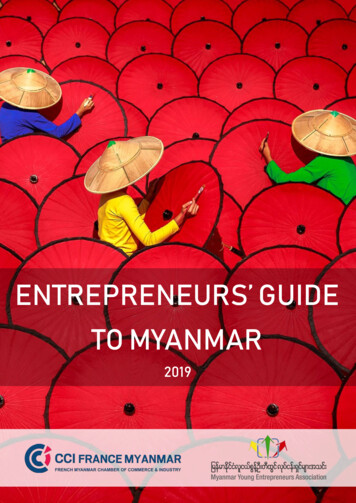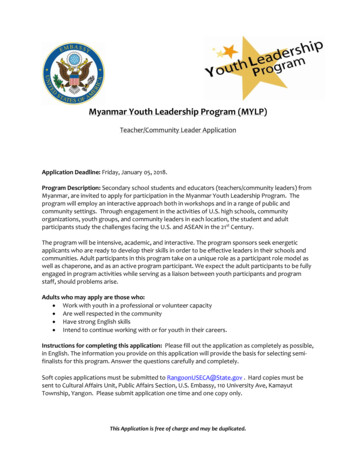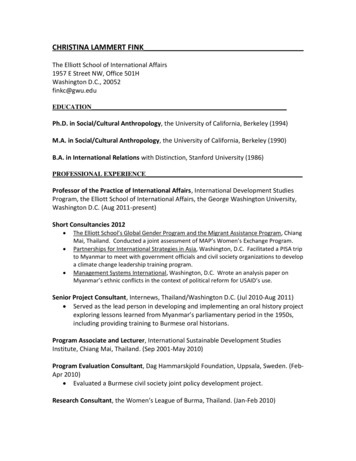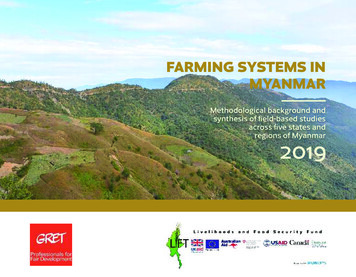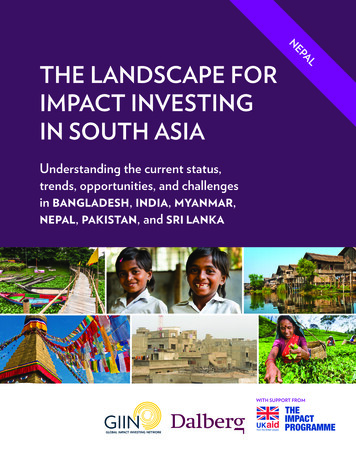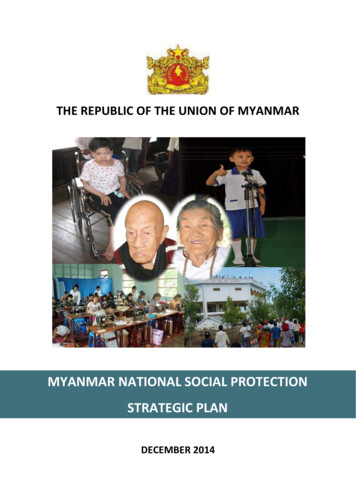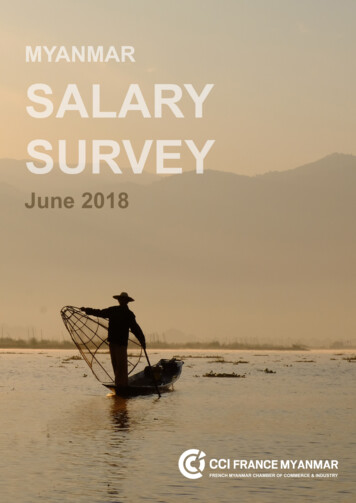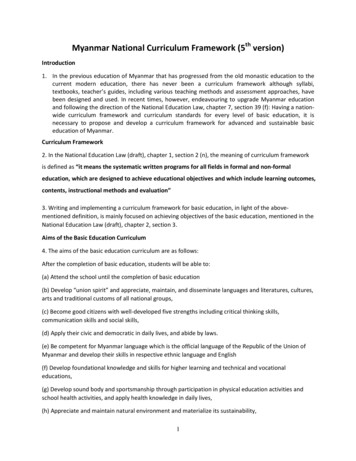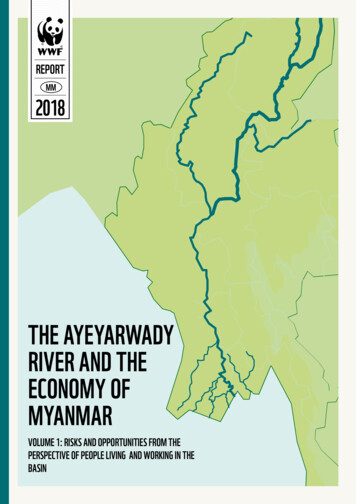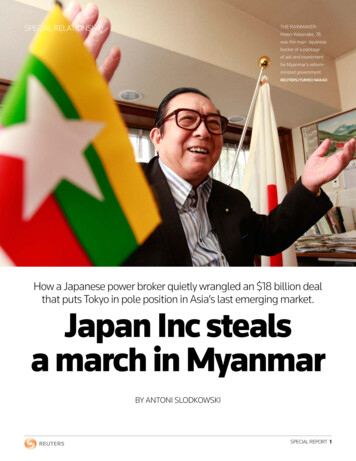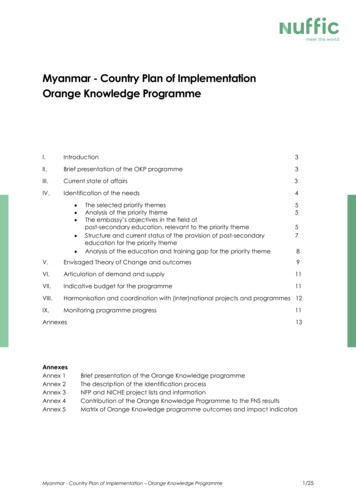
Transcription
Myanmar - Country Plan of ImplementationOrange Knowledge ProgrammeI.Introduction3II.Brief presentation of the OKP programme3III.Current state of affairs3IV.Identification of the needs4 The selected priority themesAnalysis of the priority themeThe embassy’s objectives in the field ofpost-secondary education, relevant to the priority themeStructure and current status of the provision of post-secondaryeducation for the priority themeAnalysis of the education and training gap for the priority theme55578V.Envisaged Theory of Change and outcomes9VI.Articulation of demand and supply11VII.Indicative budget for the programme11VIII.Harmonisation and coordination with (inter)national projects and programmes 12IX.Monitoring programme progressAnnexesAnnexesAnnex 1Annex 2Annex 3Annex 4Annex 51113Brief presentation of the Orange Knowledge programmeThe description of the identification processNFP and NICHE project lists and informationContribution of the Orange Knowledge Programme to the FNS resultsMatrix of Orange Knowledge programme outcomes and impact indicatorsMyanmar - Country Plan of Implementation – Orange Knowledge Programme1/25
List of abbreviationsCARTCCentral Agriculture Research and Training Center (in-service training)CPICountry Plan of ImplementationCSAClimate Smart AgricultureECDEnvironment Conservation DepartmentEKNEmbassy of the Kingdom of the NetherlandsFNSFood and Nutrition SecurityGGGGlobal Green Growth InstituteHEHigher EducationITCIrrigation Training CenterIWRMintegrated Water Resource ManagementMoALIMinistry of Agriculture, Livestock and IrrigationMMUMyanmar Maritime UniversityNWRCNational Water Resources CommitteeNESPNational Education Strategic PlanNFPNetherlands Fellowship ProgrammeNICHENetherlands Initiative for Capacity Development in Higher EducationNufficThe Dutch organisation for internationalisation in educationNWPNetherlands Water PartnershipOKPOrange Knowledge ProgrammePSDPrivate Sector DevelopmentSAIState Agricultural InstituteTOCTheory of ChangeTVETTechnical and Vocational Education & TrainingYTUYangon Technical UniversityMyanmar - Country Plan of Implementation – Orange Knowledge Programme2/25
I.IntroductionThis document describes the purpose and intentions of the implementation of the OrangeKnowledge Programme (OKP) in Myanmar. It follows on an identification process in whichcapacity needs in the Myanmar have been analysed in the light of the available informationand discussions with stakeholders. This approach has helped to define the priority interventionarea(s) and to formulate the outcomes to be achieved.The Dutch organisation for internationalisation in education (Nuffic), administers thisprogramme on behalf of the Ministry of Foreign Affairs of the Netherlands. Nuffic is responsiblefor its implementation and follow-up in accordance with the Myanmar Country Plan ofImplementation (CPI).II.Brief presentation of the Orange Knowledge programmeThe Orange Knowledge Programme is the successor to the Netherlands FellowshipProgrammes (NFP) and the Netherlands Initiative for Capacity Development in HigherEducation (NICHE). The Orange Knowledge Programme merges the two precedingprogrammes into a single integrated approach, with the addition of new elements includingincreased involvement of alumni, attention to cooperation between knowledgeorganisations, and communication focusing on the presentation of results.The main objective is to contribute to sustainable and inclusive development through thestrengthening of organisations key to sectoral development in OKP partner countries. This willbe achieved by developing the capacity, knowledge and quality of individuals as well asorganisations both in the field of Technical and Vocational Education and Training andHigher Education (TVET/HE) and in other fields related to the priority themes in the OKPpartner countries.The Orange Knowledge Programme will be implemented through three types of interventions:individual scholarships;group trainings;institutional projects focusing on sustainable improvement of technical and highereducation capacity.For further information on the OKP reference is made to annex 1.III.Current state of affairsIn the 2008 Constitution Myanmar has shifted to a democratic governance system with acivilian-led government and two parliaments with elected representatives in 2011.Myanmar - Country Plan of Implementation – Orange Knowledge Programme3/25
The government is making efforts to end armed conflicts, undertake national reconciliationand establish peace within the country’s borders. Following the recent handover to a civilianled government, international sanctions are being reviewed. Foreign investment is expectedto increase in the coming years. Myanmar’s recent economic growth has been impressive.The agriculture sector in Myanmar occupies a dominant position in the development of thenational economy and has a definite bearing on other socio-economic activities. About 75%of the total population reside in rural areas and are principally employed in the agriculture,livestock, and fishery sectors for their livelihood. Myanmar, a lower-middle income economywith a GNI per capita of 1,455 in 2017, is one of the fastest growing economies in the EastAsia and Pacific region and globally. The GDP growth rate for 2016/2017 was 6.4 percent andis expected to remain the same in 2017/18, growing to 6.7% in 2018/19 and 7 percent in2019/2020, mainly driven by services, industry and agriculture. Poverty in Myanmar hasdeclined from 44.5% in 2004 to 37.5% in 2009/10 and 26.1% in 2015, according to the recentMyanmar-World Bank joint poverty analysis. However, poverty remains substantial, especiallyin rural areas where people rely on agricultural and casual employment for their livelihoods.Those who live near the poverty line are susceptible to economic shocks. Growth may behampered by challenges including the ongoing and incomplete peace process with multipleethnic armed organisations and the crisis in Rakhine State. The country must continue toimprove its investment climate, banking sector and strengthen its implementation capacityon major reform programmes. Myanmar is a country abundant of natural resources, a youngworkforce and a lot of potential. However, as an emerging economy there are still manyissues in the regulatory framework, in the financial architecture, and in the skills and capacityof the workforce. Therefore, Myanmar provides an excellent opportunity to implement theDutch aid-and-trade approach. The ongoing NICHE programme encompasses two ongoingprojects in (I) Capacity development on Integrated Water Resources Management inMyanmar and (ii) Vocational training in agriculture. NFP tailor made training has also focusedon water and agriculture (see annex 2).Political situation MyanmarThe political situation in Myanmar is complex. We recommend everyone who is or will beactive in Myanmar, to maintain informed on the political situation in the country and theofficial standpoint of the Netherlands. For more information on the political situation inMyanmar, please visit the public website of the Ministry of Foreign Affairs of the Netherlands(click here).IV.Identification of the needsThis section describes the main outcomes of the needs assessment and covers thegender/inclusion and labour market situation in relation to post-secondary education in thecontext of the selected priority themes.Myanmar - Country Plan of Implementation – Orange Knowledge Programme4/25
The selected priority themes1. Food and Nutrition Security (FNS) specifically Agriculture, which includes Livestock andAquaculture;2. Water efficiency, sustainability and equitability, ensuring the needs of all sectors andthe environmentAnalysis of the priority themesTheme 1: Food and Nutrition Security (FNS) specifically Agriculture, which includes Livestockand AquacultureMyanmar is an agricultural based country and the agriculture sector is the backbone of itseconomy. It contributes to 34% of Gross Domestic Product (GDP), 30% of total exportearnings, and employs 56% of the labour force. About 75% of the total population reside inrural areas and are principally employed in the agriculture, livestock, and fishery sectors fortheir livelihood. Rice is historically the most important and dominating crop. Despite theenormous potential of the agricultural sector, it has underperformed in the last fifty years. It isexpected that the population will grow to about 60 million in 2030 and the demand for riceand other agricultural produce for consumption will grow.Myanmar’s economy is heavily reliant on the agricultural sector and extractive industries. Inorder to achieve sustainable economic development, Myanmar needs to reduce its relianceon natural resources and expand the services and manufacturing sectors. At the same time,there is a need to use modern technology to produce quality products in the agriculturalsector.Theme 2; Water efficiency, sustainability and equitability, ensuring the needs of all sectors andthe environment.Myanmar has abundant water resources at the national scale. It has more water per capitathan all the neighbouring countries. Most of its water resources are within the national bordersand 3 out of 4 are national rivers. However, there is inability to access water and to properlymanage increasing local and seasonal variability of supply due to climate change. Resultingdroughts and floods negatively affect livelihoods and economic development. Rapiddevelopment and change are putting pressure on water resources, with emerging risks ofcross-sectorial competition, over exploitation and pollution. Much of the prevailing povertyand food insecurity is caused by improper water management.The Embassy’s objectives in the field of post-secondary education, relevant to the themesMyanmar has an indicative total allocation of 688 million of EU's support under the Multiannual Indicative Programme 2014-2020. The Netherlands contributes the following total EUallocations: Rural development, agriculture and food and nutrition security ( 241 million) andEducation ( 241 million).Myanmar - Country Plan of Implementation – Orange Knowledge Programme5/25
In 2012, Myanmar expressed interest in cooperating with the Netherlands in managing itswater challenges. For that reason, both countries signed a Memorandum of Understanding(MoU) on cooperation in the field of Integrated Water Resources Management (IWRM).Since 2013, the Netherlands assists Myanmar in capacity building in IWRM: in these yearsuniversity cooperation, learning by doing projects and feasibility studies have been executed.In 2017, the Delta Core Team in the Hague and the embassy, anticipating on the ending ofthe 3-year funding, developed a strategy focussing on the core interventions in the YangonUrban Delta. In short Dutch knowledge on IWRM, resilient cities and the agro-water nexus willhelp Myanmar and the major investors to make the right decisions for large scaleinfrastructural projects. Technical support focusses on assisting master planning to take intoaccount long-term sustainability and financial feasibility, helping Myanmar in its rights-baseddevelopment and in its diverse relations with other donors to avoid as much as possibleunintended negative consequences.Based on the existing MoU, the Dutch support has been concentrated on strategiccooperation in the Ayeyarwady Delta. However, it is clear that a substantial part of futureinvestments and most of the strategic interventions will done in the Greater Yangon area. TheDutch International Water Ambition (IWA) is also focusing on urbanising deltas.An ongoing NICHE project was formulated (see annex 2) to cover capacity building in watereducation.For the Netherlands embassy capacity building is considered a key success factor forintegrated development of water resources and is required at all levels, For Myanmar it isimportant to upgrade the ability and capacity to analyse and predict behaviour of the Deltaand effects of interventions (disaster risk mitigation, and mitigating risks of interventions forwater quality and availability). Within the new Orange Knowledge Programme (OKP),relations between Myanmar and Dutch knowledge institutes will be strengthened.A second MoU, endorsed in May 2015, covers cooperation in the field of agriculture, foodsafety, livestock, fisheries and farmers’ organisations. Joint efforts should generate moreincome and employment for rural people, improve the provision of safe and healthy food,and increase the Gross National Product and export earnings. At the same time, long termsustainability should be ensured of the agriculture sector as a whole and of ecosystemssupporting the sector and the rural economies. An ongoing NICHE project was formulated(see annex 2) to cover the missing element in capacity building in agriculture education.Mostly based on this MoU, the current Myanmar Netherlands Agricultural Programme (MNAP)is ambitious and driver for many modernisations and transitions in Myanmar, such as seedorganisation and integrated seed sector development, modernising farmers co-operatives,sector and value chain developments, with focus on horticulture (e.g. vegetables, potatoes,flowers, pulses and beans) and livestock. For livestock the plan focused initially on poultry with2 multi-year programmes and for fisheries on export to EU and is currently investigating NL(business and governmental) support to the development of a dairy sector. This specificsector is currently effectively not existing, leading to huge and costly import of all kinds ofdairy products. Together with research institutes and private sector parties the bilateralprogramme of the Netherlands with Myanmar promotes the development of multi-yearprogrammes on soils. It also covers capacity building to help Myanmar to develop e.g. theMyanmar - Country Plan of Implementation – Orange Knowledge Programme6/25
Plant Protection Division of the Ministry of Agriculture Livestock and Irrigation to become theinternational recognised Competent Authority for phytosanitary affairsStructure of the current status of the provision of post-secondary education in the prioritythemes selectedMyanmar has 171 higher education institutions (colleges, degree colleges and universities),which are overseen by eight ministries. In the 2015 academic year, there were 225,178students studying full-time in HEIs under the responsibility of the Ministry of Education, while anadditional 411,164 students were accessing higher education through Distance EducationUniversities.Access to technical and vocational education and training in Myanmar is provided byrelevant ministries and the private sector through 372 technical and vocational educationand training centres.The needs of higher education in Myanmar are extensive. The entire system requires acomplete renovation, from the physical infrastructure to the academic curriculum, and to thecapacity of administrative and academic staff. The physical infrastructure is in a serious needof repair or replacement. Some of the laboratories are outdated with equipment that oftenwas purchased back in 1960’s. Most of the curricula being offered are outdated. There isneed for emphasis on English language training. The quality of instruction is poor. Manyexisting faculty members do not have post-graduate degrees. They do not have experiencein peer review, managing projects engaging on international collaboration. And also manydo not have the experience of the close connection between research and teaching. Thereis no access to digital journals because of the poor state of the internet and the lack ofinformation technology infrastructure, software and hardware, and computer modelshamper the linking and networking among universities, professionals, and students. The newNational Education Strategic Plan (NESP)1 is a comprehensive, widely-owned and evidencebased roadmap intended to reform the entire education sector over the next five years, from2016-2021.The agricultural education system in Myanmar includes three universities, all under differentministries and focused on different segments of the agricultural sector. The Yezin AgriculturalUniversity, under the Ministry of Agriculture Livestock and Irrigation, covers crop sciences andin addition offers some courses in animal sciences and fisheries. Yezin Agricultural Universityalso operates seven regional research stations where it deploys students to conduct researchduring their final year. The University of Veterinary Science offers veterinary sciences andfisheries but not crop agriculture. The University of Forestry under the Ministry of EnvironmentalConservation specializes in issues of land management, environment and forestry.In addition to these degree-conferring institutions, seven State Agricultural Institutes (SAI) 2offer the agricultural education diploma programme for high school graduates since 1955. 01/NESP 20Summary 20- 20English 20- 20Final 20 20Feb 2023.pdf2 Pyinmana SAI, Thahtone SAI, Myaungmya SAI, Shwebo SAI, Patheingyi SAI, Pwintphyu SAI, and Tharyarwady SAI1Myanmar - Country Plan of Implementation – Orange Knowledge Programme7/25
Students gain a Diploma in Agriculture after they completed three-year studies. The top tenoutstanding students can join the third-year study of undergraduate programme at YAU forpursuing a Bachelor of Agricultural Science Degree if they pass the entrance examination.The water education system is still limited and covers universities which deliver professionalswith specialization in water resources management, the Yangon Technological University,and the Mandalay Technological University both supervised by the Ministry of Science andTechnology, the Maritime University of the Ministry of Transport and the Forest University of theMinistry of Environmental Conservation and Forestry which offers courses on watershedmanagement. There are no vocational training schools that specifically focus on watereducation. The water education sector is characterised by higher numbers of femalestudents and teaching staff.Analysis of the education and training gap in the priority themeMyanmar currently is facing two major challenges to expand priority development sectors:(a) a shortage of skilled workers, despite increased job opportunities;(b) limited governance and public sector management capacity.High-quality higher technical and vocational education and training that equips Myanmar’seconomy with a skilled and competitive workforce is vital for sustainable socio-economicdevelopment. In the coming years a large number of skilled employees will be needed for theagricultural, water, energy, manufacturing, infrastructure, livestock, fisheries and tourismsectors. To address this demand the higher and TVET system will need to equip learners with theknowledge, skills and competencies to achieve their career aspirations and contribute toeconomic growth.Higher education is responsible for nurturing skilled human capital needed in government,business and industry. Higher education institutions (HEIs) have a key role to play inundertaking research and incubating the innovative and creative thinking needed forglobally and economically competitive society.The three major challenges facing TVET/higher education in the priority sectors are: High-quality, accessible and integrated TVET/higher education is a pre-requisite forincreasing employment, poverty reduction and sustainable economic growth. Demanddriven TVET/higher education that is accessible to school leavers. It plays an important rolein addressing youth unemployment and boosting Myanmar’s economy; Enhancing the quality of TVET/higher provision is critical in order to sustainably provideemployment to meet the increasing demand from both school leavers and employers; Management and co-ordination need to be strengthened through a more cohesivelegislative and policy framework that covers the entire TVET/higher education sector.The objective of the TVET/higher education policy of the government of Myanmar is to equiplearners with the knowledge, skills and competencies that will enable them to find employmentand achieve their career aspirations. The ongoing NICHE project ‘Strengthening AgriculturalVocational Education and Training Schools in Myanmar’ that started in 2017 is aiming for thatobjective as well.Myanmar - Country Plan of Implementation – Orange Knowledge Programme8/25
1. Food and Nutrition Security (FNS)The number of challenges Myanmar faces is large. OKP Support to Agricultural Institutes isessential in the following areas: Adapt agricultural curricula to Higher Education Applied Sciences level; Including teacher training; Increasing labour market focus including internships, agrobusiness workshops and minienterprises skills development; Training more middle level agro-technicians; Increasing awareness with students at different universities around agri-business/farmmanagement, marketing-inputs, finance, value chain analysis; Strengthening embedding of curriculum at agricultural Research centres linked to MOALIfor system change.2. Water efficiency, sustainability and equitability, ensuring the needs of all sectors and theenvironmentThe knowledge gap in the water sector is substantial. Currently, several initiatives are beingformulated, under the auspices of different donors and funds, to improve capacity buildingand education in the field of IWRM and water governance. Capacity building is considered akey success factor for integrated development of water resources and is required in all levels.Relevant aspects for capacity building are: Strengthen existing capacity of key Ministerial departments; Capacity building at Universities and Ministerial training centres and include more‘learning by doing; Build up the knowledge and experience on integrated water resource management inthe two deltas; Upgrade the ability and capacity to analyse and predict behaviour of the Delta andeffects of interventions (disaster risk mitigation) in order to enhance water managementfor food security; Tackle data management; sharing Monitoring and Evaluation data in a structural wayand monitoring of baseline data tidal rivers/ground water; Enhance awareness of local water users; Build up a structured and holistic research programme for climate change impacts andadaptation.V.Envisaged Theory of Change and outcomesBased on the analysis of needs and the consultations with the stakeholders, a theory ofchange for Myanmar has been formulated in (i) Food and Nutrition Security (FNS) and (ii)Water.This ToC is based on the general OKP ToC and describes the way the OKP programme willcontribute to the Dutch development cooperation policy as described here. The OKP M&EMyanmar - Country Plan of Implementation – Orange Knowledge Programme9/25
framework is intended to make clear that all interventions within OKP should be geared tocontribute coherently and measurably to common long term impacts, as defined by theMinistry of Foreign Affairs e OKP programme in Myanmar aims at the following objectives, outcomes and impact:Global Outcome Agro FNS & Water: The OKP programme contributes to efficient watermanagement in climate smart and inclusive agriculture for ecologically sustainable foodsecurity in Myanmar.The OKP programme in Myanmar aims at the following objectives, outcomes and impacts:Objectives:Contribute to End hunger, achieve food security and improved nutrition and promotesustainable agriculture (SDG 2) and ensuring availability and sustainable management ofwater for all (SDG 6).The following long-term impact will be aimed at:1.2.3.Promote agricultural growth;Water is used sustainably and equitability, ensuring the needs of all sectors and theenvironment;Water efficiency in agriculture increased.The following medium-term impact will contribute to this:(I)(II)(III)Education system (HE/TVET) is of good quality, relevant and accessible (SDG 4);Partnerships between persons and organisations are inclusive and sustainable (SDG 17);Organisations key to (sectoral) inclusive development of partner countries arestrengthened by inflow of enhanced workforce.This will be achieved by the following outcomes:A.B.TVET/HE organisations (in the selected partner countries and in NL) perform better theircore tasks, firmly embedded in their environment (in line with Myanmar / regionalspecific labour market needs & aiming at inclusiveness);Enhanced knowledge and skills of individuals and organisations in line with Myanmar /regional specific labour market needs & aiming at inclusiveness (in Myanmar and in theNL).Annex 3 describes the Theory of Change for Myanmar for Food and Nutrition Security (FNS/and Water efficiency, sustainability and equitability, ensuring the needs of all sectors and theenvironment.Annex 4 provides an M&E matrix presenting the expected outcomes and connectedindicators for the OKP country programme.Myanmar - Country Plan of Implementation – Orange Knowledge Programme10/25
VI.Articulation of demand and supplyThe OKP offers different kind of capacity building interventions (see Annex 1):1. partnership projects between TVET and higher education institutions locally and withthe Netherlands;2. Tailor-Made Training courses (TMT) for groups;3. individual scholarships for mid-career professionals;4. Alumni events.Nuffic will publish calls for institutional cooperation projects and group training. Based onthose calls, key organisations in Myanmar and in the Netherlands are invited to submitproposals that are aligned with the CPI and contribute to the ToC outcomes and impact inannex 3 and 4. Please refer to the policy framework that underlies the OKP and anexplanation of the various modalities.For scholarships, please consult the OKP scholarship website. For updates on calls and otherOKP information, please register via the OKP updates website.Preliminary planning of implementationStepCPI published on Nuffic websiteFirst call publishedDeadline callSelection partnersStart of project in case joint proposalsVII.DateFebruary 20191Q2019t.b.d.t.b.d.2Q2019Indicative budget for the programmePeriod of implementation 2019 –2022Efficient water management in climate smartagriculture for food securityInstitutional projectsEUR 2,240,000Tailor-Made Training EUR 400,000Tailor-Made Training and otherGroup trainingEUR 360,000Individual scholarshipsEUR 1,000,000Alumni eventsPMTotal EUREUR 4,000,000Myanmar - Country Plan of Implementation – Orange Knowledge Programme11/25
*) The budget for Tailor-Made Training, other Group training and Individual scholarships ismanaged centrally and will be divided as much as possible evenly over all full programmecountries provided that sufficient eligible and quality applications will be received.Note: The funds allocated to the programme as a whole and to each partner country’sprogramme may be subject to change. The budget may also change in line with politicaldecisions taken by the authorities. As a consequence, Nuffic reserves the right to adjust thisindicative budget and, it will notify the relevant parties immediately if adjustments are beingmade.OKP promotes co-funding and matching of funds. Myanmar is classified by the OECD as anLDC [1]). Proponents applying for Tailor-Made Trainings and Institutional Partnership projectsare encouraged to include co-financing in any form in their proposals. This will contribute toreciprocity and ownership of results established within the collaboration between all partners.Co-financing in the breakdown of budgets will be one of the assessment criteria in theselection of proposals.VIII.Harmonisation and coordination with (inter)national projectsand programmesIn consultation with the embassy, Nuffic will organise monitoring missions during whichmeetings will be arranged with the relevant authorities and other stakeholders (TFPs, NGOs,the private sector, etc.), for the purpose of discussing any contextual changes that couldimpact the implementation of the OKP programme. In addition, the two NICHE projects on (i)Capacity Development on Integrated Water Resources Management in Myanmar and (ii)Strengthening of Vocational Education and Training Schools in agriculture, livestock andirrigation will link the OKP initiatives to both priority sectors. The OKP initiatives will also becoordinated with the bilateral agricultural programme between Netherlands and Myanmarlaid down in a multi-annual country strategy. The Netherlands Water Partnership joins Dutchpublic and private sector water partners operating in Myanmar and the OKP is alreadyestablishing contacts with this network agency. For the Netherlands government in theirbilateral relations with Myanmar, Nuffic has been instrumental in strengthening of capacity inwater/agriculture through its NICHE-and OKP programme. The programmes are alsoconsidered important pillars for sustainable development as well as for peace/security. OKPlinkages will also strengthen the other bilateral programmes.The New Zealand government assistance with vocational training support in thelivestock/dairy sectors is already providing linkages with the ongoing NICHE project and isexpected to continue with prospective OKP initiatives in the food security sector.[1]OKP countries are classified in accordance with the list of Development Assistance Committee (DAC list) of theOECD.Myanmar - Country Plan of Implementation – Orange Knowledge Programme12/25
IX.Monitoring programme progressThe organisations taking part in the OKP programme are asked to report on the progress oftheir projects and scholarships using a Results Oriented Monitoring tool that will be providedby Nuffic. They will also record their successes and setbacks so that lessons can be learnedfrom them as part of an organisational learning approach.Nuffic will monitor and evaluate the OKP at programme level
Myanmar - 6Country Plan of Implementation - Orange Knowledge Programme /25 In 2012, Myanmar expressed interest in cooperating with the Netherlands in managing its water challenges. For that reason, both countries signed a Memorandum of Understanding (MoU) on cooperation in the field of Integrated Water Resources Management (IWRM).
